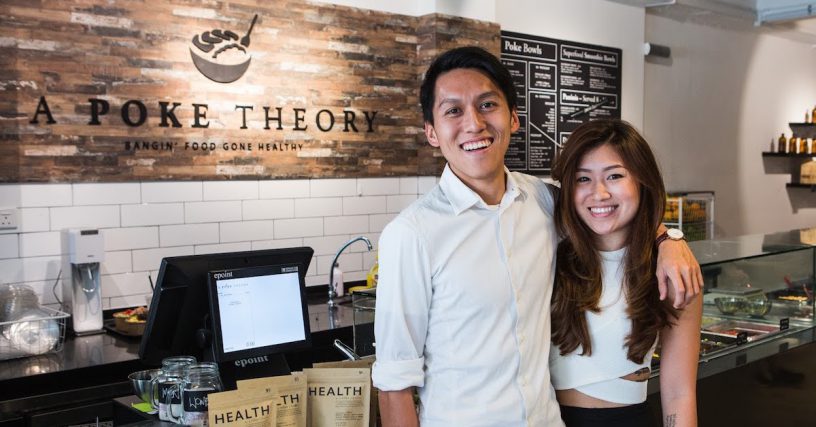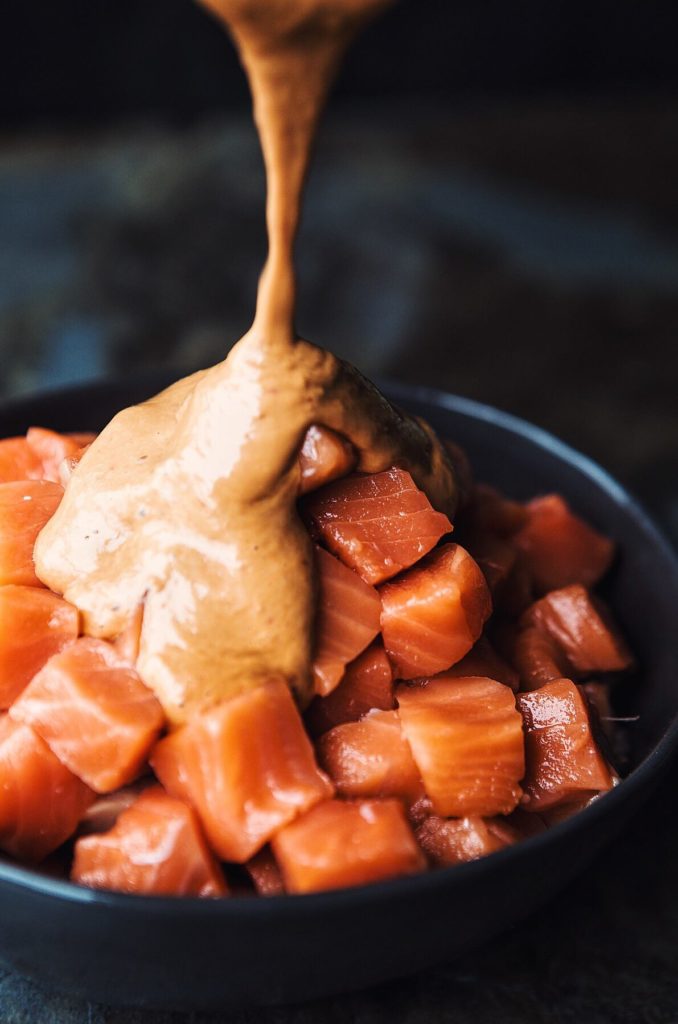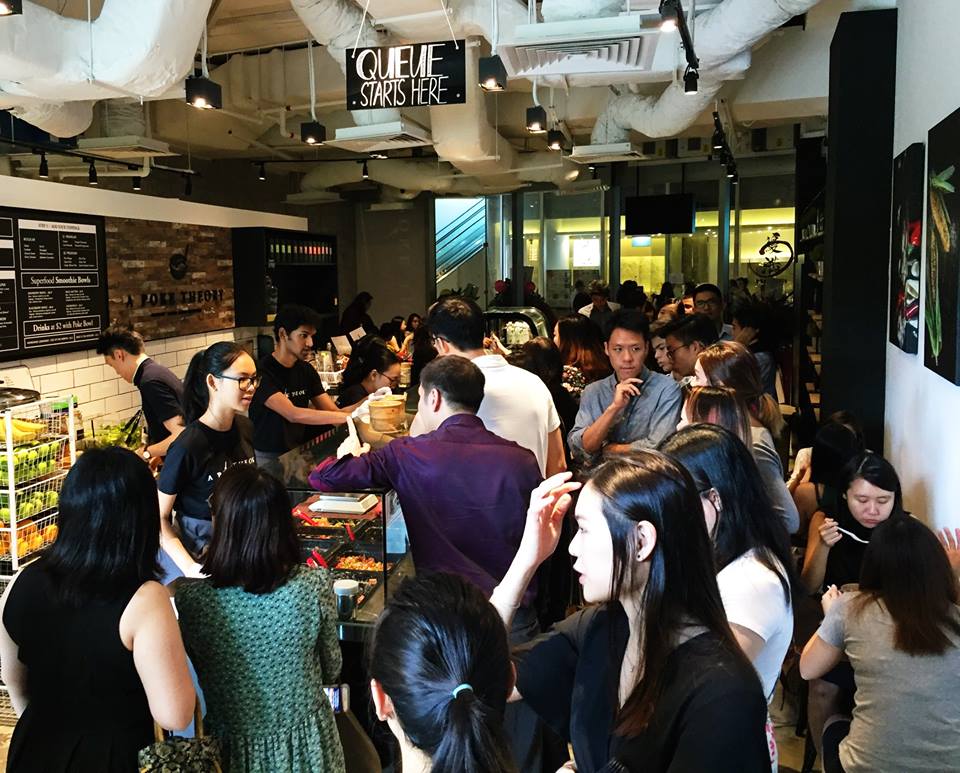At 24 and 26 respectively, Joey and Vannessa are as young as the waiters and waitresses they employ. Yet, they are already owners of 2 successful restaurants – A Poke Theory & Alter Ego – housed under the F&B group, Tandem Collective.
Interested to find out more about their success, I reached out to Joey to uncover the secret behind what makes A Poke Theory so popular, despite having opened for only a year.
Joey is an interesting dude. To me, he feels “unusually ambitious”, a person who has strong ambitions for the future, yet it is not show-offy, not like a Steve Jobs or a Gary Vaynerchuk-type of person. There is a kind of quiet strength to him, a “I’ll prove you wrong” vibe but this sentiment is not expressed aggressively.

Joey and Vannessa. Credits: Vulcan Post
Anyway, Joey’s secret ingredient is surprisingly simple: be relentlessly obsessed with your customer.
By that I mean – always have the customer experience in mind, and continue to discover what they want and how to give it to them.
This is not a checklist item. You can’t just create a task called “obsess with customers” and then check it off after conversing with a few of them in your restaurant. It HAS to be fully embodied in your culture and values, a perpetual process you follow to give them the ultimate experience of dining in your restaurant.
Below, you’ll see 3 particular stories where they showed off their customer obsession, making tweaks that eventually cemented their brand.
Customer Obsession #1: “Free Sauce Theory”
When A Poke Theory first started, it was just like any other restaurant. Order your poke bowl, choose your sauce and the service staff would do it for you.
However, upon close observation, Joey began realizing that customers kept coming back after ordering, complaining that their poke bowls were too dry, and needed more sauce.
But it was also difficult for customers to top up the sauces themselves. The sauce bottles were all behind the counter — so they had to wait for a service staff to be free so that they could tell them to add more sauces.
It was a bottleneck – both for A Poke Theory and the customers.
Joey’s best friend, who was helping out at A Poke Theory suggested to Joey that they could put squeeze bottles at the front, and allow the customers to customize the amount of sauce.
Essentially, she was suggesting to give away free sauces to ALL their customers.
Wait, what. Free sauces?!

Free sauce please
While most owners would balk at the decision, and pop their eyeballs over the potential incurred costs, it was a new ‘revelation’ for Joey.
As an ex-food journalist, Joey knew that Singaporeans loved sauces. As a restaurant owner, he wanted to see his customers enjoy his poke bowls.
He wanted them to leave A Poke Theory smiling, happy they had eaten the best poke bowls of their life. They are, in his words, a “breath of fresh air for the corporate people who are suffering from boredom.”
So, he said yes.
Right after Joey allowed free sauces, he began noticing how much happier his customers were.
And that’s when he knew – he made the right decision.
In fact, free sauces is now a significant part of A Poke Theory’s brand identity. Any franchisee who wants to franchise A Poke Theory HAS to give free sauces, if not they will be denied.
Customer Obsession #2: The “Edamame Dilemma”
Like any restaurant owner, Joey is especially sensitive to reviews about his food. Reviews are his “feedback mechanism”, and he cannot, and will not let a bad review slide without looking into his processes and making sure everything is going well.
Some time after A Poke Theory had launched, Joey began discovering reviews that said his poke bowls were bland.
To Joey, that was impossible. After all, Joey was a person who likes aggressive seasoning. And almost everything at A Poke Theory is seasoned.
The sushi rice is seasoned. The quinoa is seasoned. All the premium ingredients A Poke Theory offers has seasoning. Even the lettuce that is used as the base of the poke bowl has dressing.
Yet, the opposite was happening.
Customers were actually complaining that the food was bland. Was there something off? Did Joey under-season too much? Was his tastebuds off?
He had to find out what happened.
Then, it struck him.
Do you know what edamame is?

Edamame is a preparation of immature soybeans (usually served with the pod), found in cuisines in East Asia (especially Japan). And edamames were used as one of the free toppings A Poke Theory offers for their poke bowls.
The thing is – edamame is polarizing. Those people who get edamame love it (like me). They want edamame on everything and anything. Those who don’t find it bland.
Also, edamame has a very distinctive flavour profile that can overpower most seasoning, and taste like well, edamame. In of itself, edamame isn’t that tasty or flavourful.
And THAT is the problem.
Edamame was a free topping offered to all A Poke Theory’s customers. And because it was free, customers were happy to just have it, without considering whether they liked it or not.
Joey had found his culprit. It was the edamame.

Curse you, edamame
But, he couldn’t just remove it. If he did, he would alienate his edamame-loving customers. If he didn’t, his pokebowls would continue to be bland.
With a stroke of genius, he killed 2 birds with one stone.
He had done taste tests with his suppliers, and have discovered a powerful ingredient in which he could use to replace edamames.
Then, he took the edamames, marinated them in terikyaki sauce and turned them into teriyaki edamames, which he upsold to customers as a premium ingredient.
With an act of genius, he managed to solve his problem, placate his customers and make more revenue. With his new ingredient, the furikake seaweed, the poke bowl became even more delicious and impactful – reducing the chances of anybody ever complaining that his food is bland. Then, with the teriyaki edamames, he kept his edamame-loving fanbase, who loved edamame so much that they didn’t mind paying a dollar extra just to have it.
By obsessing over different “customer segments”, Joey was able to discover a solution that could make everyone happy.
It was a huge win for A Poke Theory.
Customer Obsession #3: “Look In The Bin”
“That is probably what keeps me going. Because, honestly if my customers don’t like my food, I would just give up. We are doing this for the customers and I really love it when people tell me that they love my food.”
Just because you don’t have bad reviews doesn’t mean everything is going well. You must consider the silent majority.
There are a significant number of people who visit A Poke Theory and are dissatisfied, but they don’t put their comments on Facebook, Instagram, YouTube or their blogs.
They simply tell their friends.
And that is the worst that could happen to any restaurant.
The F&B industry is notoriously difficult to thrive in not simply because of how competitive it is. It’s because as long as one customer has a bad experience, he or she will never be back ever again.
And? They will tell their friends. They will tell them about how much the food sucks, how bad the service is and so on.
So, just because you don’t have bad reviews doesn’t mean you’re “safe”. Just because you don’t have bad reviews doesn’t mean you’re “fine” now.
What you need is to be raved about. People need to love your food so much that they are organically telling all their friends in-person, or on social media.

Raved about
And that is a constant work-in-progress.
Besides checking out reviews and looking at the PoS systems to see which food are being ordered the most, Joey has a secret technique up his sleeve on how he checks on the quality of his food.
It is his “look in the bin” strategy.
What he does is that, every day when he pops by the shop, he will open up the bin to take a look.
For him, his measure of success is simple.
If there are cubes of fish left inside a bowl in the bin, he knows something is wrong. A Poke Theory is generous with their portions, so he knows that sometimes a customer might not have enough appetite to polish off all the rice.
But leaving cubes of fish untouched? BLASPHEMY!

Why would you leave this untouched?!
To him, it signals that there is something wrong.
He will begin taste-testing all the food prepared by his chefs to see if they are slipping in their quality. By doing this, he consistently maintains the food standards – making sure that the chefs do not do slipshod work and try to get away with it.
It’s not always about the quality of food too.
Getting portioning right is important for kitchens. You want customers to walk away feeling satiated and fulfilled, and yet not waste any food.
If he discovers that his food is getting tons of rave reviews, but there are consistently leftovers, or food thrown away, then he also knows that it is a portioning issue. He will make sure his team look into the portioning of each dish, and ensuring that it is the most optimal for both business and customers.
Customer obsession is the heart of A Poke Theory’s success
“Me being so obsessive, especially on the food side keeps the chefs on their toes. By the time I look at my sales and notice a dip, the damage is already done. I have already lost my customers and there is no way to get them back. It is hard to convince someone who really thinks you’re full of shit to come back another time.”
This constant understanding of their customers, and tweaking their processes to create a better experience has skyrocketed A Poke Theory’s growth.
Besides receiving tons of requests for franchises, A Poke Theory is also looking to expand overseas. Their next biggest challenge? Their new store in Bugis.

But let’s not look at their successes and be jealous of them.
Relentless customer obsession can be learnt, and implemented by anybody. All you need is to care for the customers who come down to support you, your business and the food you create.
But I guess – that is probably the hardest thing to do in of itself.



